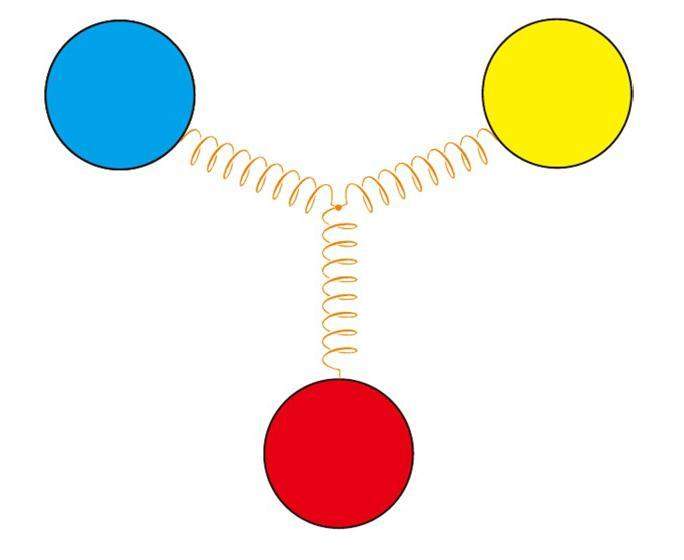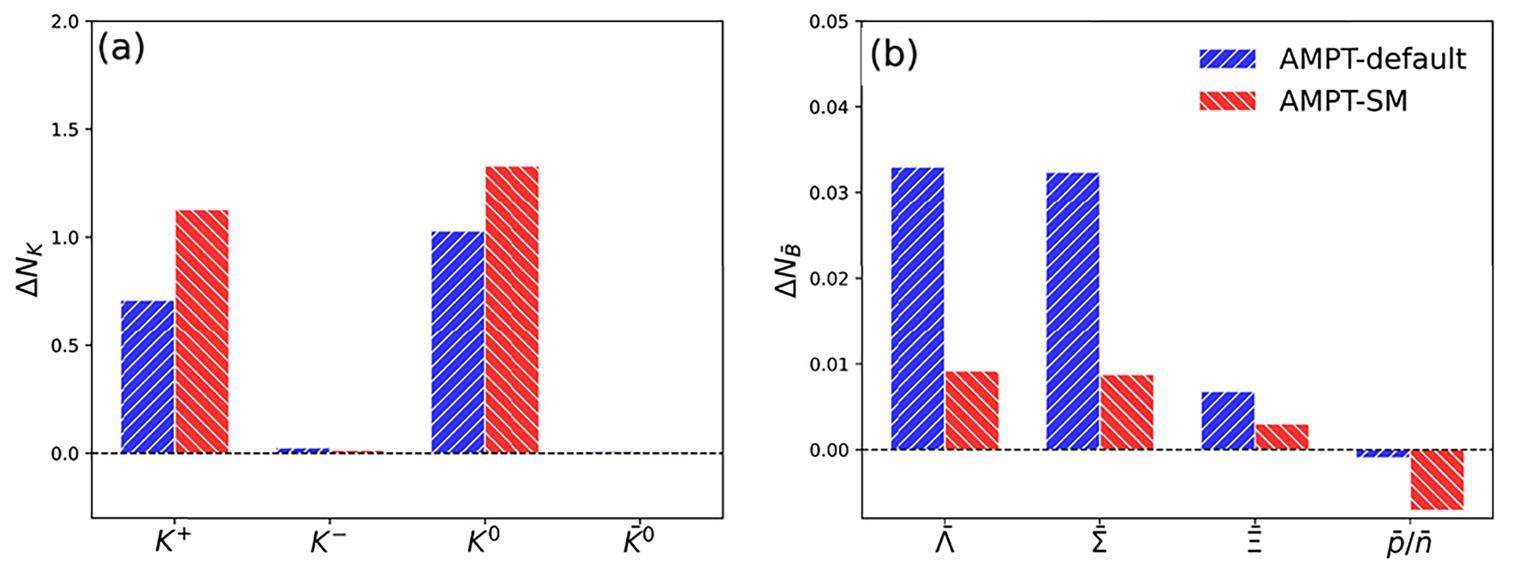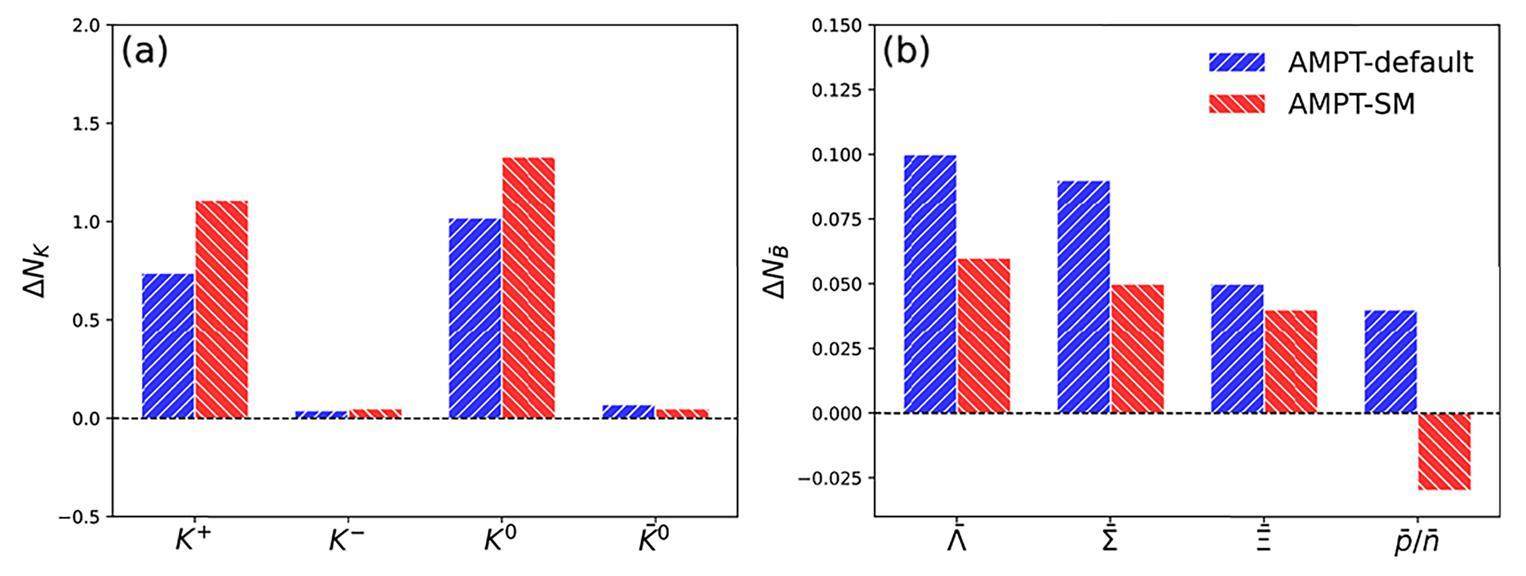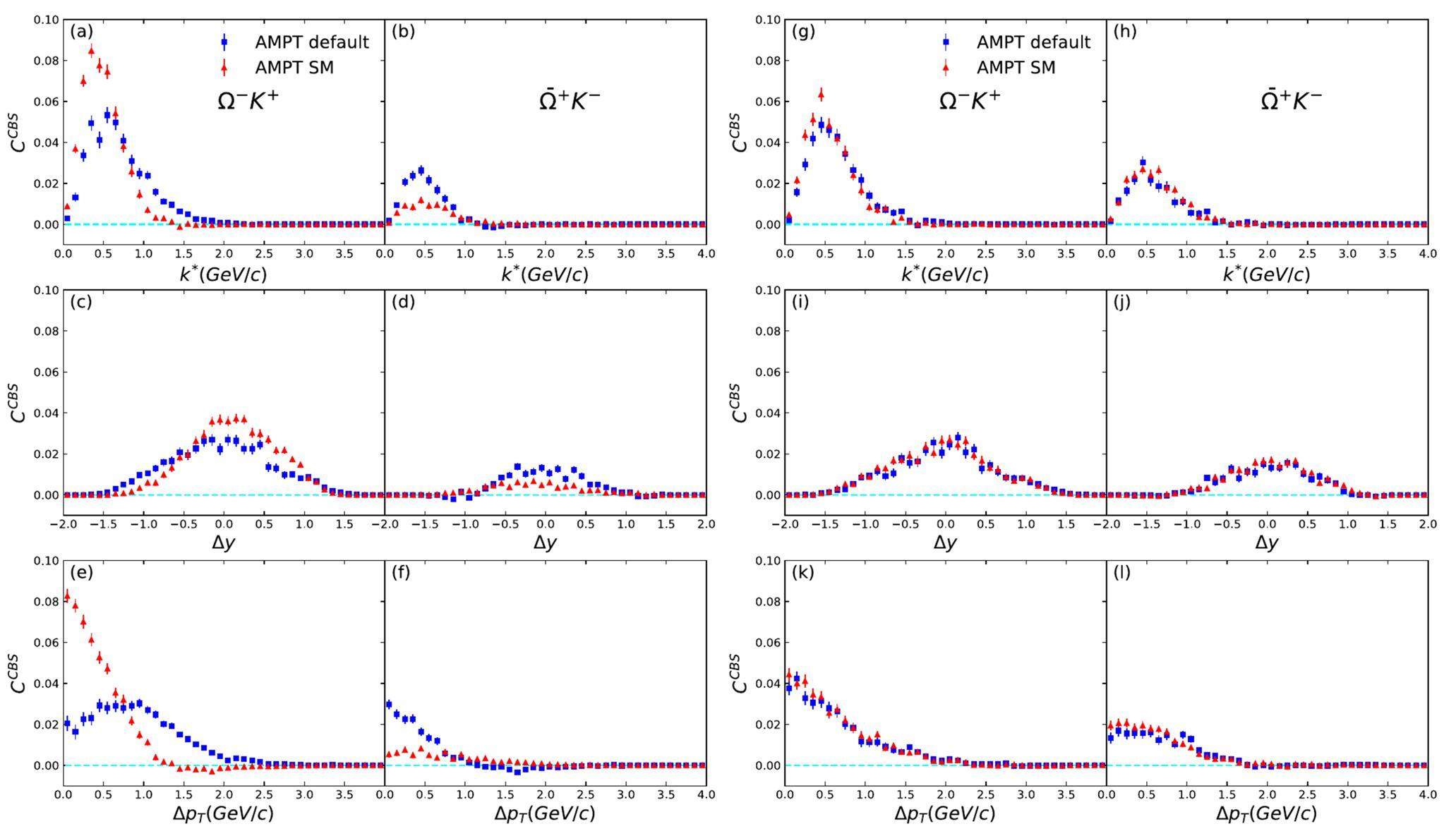Introduction
Strangeness enhancement was originally proposed as a signature of the quark-gluon plasma (QGP) created in relativistic heavy-ion collisions [1] and has been the subject of intense theoretical and experimental investigations [2-6]. Because the incident protons and neutrons are composed of u and d quarks, the strange quarks observed in the aftermath of a collision can only originate from a pair of

The RHIC beam energy scan (BES) program searches for a possible critical point in the QCD phase diagram [23], where strangeness production plays a major role [24]. At low BES energies, the measured ratios of anti-baryons to baryons are significantly lower than unity at midrapidities for three hyperons (Λ, Ξ, and Ω). Therefore, these hyperons must have net baryon numbers. Baryon number transport dynamics has been a subject of interest in heavy-ion collision physics since its inception [25-27]. The baryon number in a proton or neutron can be attributed to the valence u and d quarks, each carrying 1/3 of the baryon number. However, in high-energy collisions, valence quarks tend to inherit a significant fraction of the incident nucleon momentum, thus rendering them ineffective in transporting the baryon number from beam rapidities to midrapidities [28, 29]. Previous theoretical calculations have proposed the interactions of topological objects known as gluon junctions, as shown in Fig. 2, which can effectively convey the baryon number over large rapidity gaps in nuclear collisions [30]. Once a gluon junction reaches midrapidities during a nuclear collision, it must emerge as a baryon in the final state, where its flavor is determined by the quark flavors present in the surrounding QGP medium. These exotic dynamics have a particularly discernible effect on the net Ω hyperons, as Ω hyperons consist of three s quarks that must be pair-produced.

The quantum numbers of strangeness and the baryon number are strictly conserved in nuclear collisions, leading to correlations among the particles in the final state. To gain insight into the production dynamics of Ω hyperons, we propose to measure the correlations between Ω and other particles, namely, K+,
In this study, we use a multiphase transport (AMPT) model [31, 32] to simulate Au+Au collisions at
AMPT Simulations and Analytical Methods
AMPT Simulations
To investigate the effects of different hadronization schemes on baryon number transport dynamics, we used both the default and string melting (SM) versions of the AMPT model to simulate Au+Au collisions. The initial phase space is provided by the HIJING model [33-36], which is a Monte Carlo event generator for parton and particle production in high-energy hadronic and nuclear collisions. In the default version of AMPT, minijets and their parent nucleons form excited strings after partonic interactions with minijets, and these strings fragment into hadrons through Lund string fragmentation [37]. In the SM version, strings are converted through the "string melting" mechanism into partons, which subsequently interact during evolution, and the coalescence mechanism is used to combine partons into hadrons. The parton interactions are described by the Boltzmann equation and solved using the ZPC model [38], which includes only two-body elastic scatterings. In the quark coalescence process, the two or three nearest partons (quarks and anti-quarks) in phase space recombine to form a meson or baryon. This study uses the AMPT version that strictly conserves the net electric charge, strangeness, and baryon number. We generated more than 50 million minimum bias events of Au+Au collisions at both 7.7 and 14.6 GeV.
Ω Production and Conservation of Strangeness and Baryon Number
Ω- production is governed by both strangeness conservation (SC) and baryon number conservation. In addition, the presence of net Ω hyperons at midrapidities indicates the involvement of baryon number transport (BNT) dynamics. Figure 2 illustrates the two basic scenarios based on the quark coalescence picture for the Ω- production. In Scenario 1, or the general associate production (left side of Fig. 2), three
To characterize the numbers of kaons and anti-baryons associated with Ω production, we introduce
| Δ NK | ||
|---|---|---|
| General associate production (SC+BNT) | 3 | 0 |
| General pair production (SC) | 1, 2, 3 | 1 |
Correlation Using the Event Mixing Technique
To divide the combinatorial background, we first analyze the correlations between Ω- and strange hadrons with traditional normalization using mixed events, which is similar to the scheme used in other analyses (e.g., [39]). The correlation function is expressed as
The event mixing normalization technique enables the correlation length between two types of particles in momentum space to be investigated by analyzing their distributions. The underlying assumption is that the distribution of mixed events should be equivalent to that of the same events in the absence of any correlation. By dividing this mixed-event background, we can obtain the correlation between the two particles of interest. To achieve meaningful results, selecting an appropriate k* range for normalization is crucial. Typically, the k* range with a high counting density is selected for normalization because it provides a reliable background estimate. This method has also been applied to examine the correlation function for Ω--K+, Ω--
Correlations Using Combinatorial Background Subtraction
To make the correlation measurement sensitive to the number of associated hadrons, we introduce combinatorial background subtracted (CBS) correlations by taking the difference between the Ω- and
Correlation Results and Discussion
Strangeness Conservation and Strange Hadron Yields
Table 2 lists the AMPT simulations for determining the differences in the numbers of
| 7.7 GeV | 14.6 GeV | |
|---|---|---|
| AMPT SM | 3.22 | 3.07 |
| AMPT default | 3.25 | 3.16 |
Table 3 lists the AMPT calculations for Δ NK and
| 7.7 GeV | 14.6 GeV | |||
|---|---|---|---|---|
| Δ NK | Δ NK | |||
| AMPT SM | 2.46 | 0.017 | 2.44 | 0.119 |
| AMPT default | 1.74 | 0.078 | 1.76 | 0.28 |
Strangeness and baryon numbers can be represented by various particle types in the final states of nuclear collision. For example,


Correlations between Ω± and Strange Hadrons
We first show the correlations between Ω and strange hadrons as a function of the reduced momentum k* in the pair rest frame using event mixing normalization. Figure 5 presents the correlation functions for the (a) Ω--K+, (b) Ω--

Figure 6 shows (a) Ω--K+, (b) Ω--

Table 1 shows that the correlation between Ω and anti-hyperons may also be susceptible to the Ω-pair production scenario. The middle and right panels in Figs. 5 and 6 show the Ω--
For both beam energies, no significant difference exists in the observed correlations between the two AMPT hadronization schemes. It appears that the correlations using the event mixing technique are sensitive only to the kinematic region where SC produces
Our goal is to use the
Figure 7 shows the CBS correlations for (left) Ω--K+ and (right)

At 14.6 GeV (Fig. 7), the difference between the two hadronization schemes is relatively small. The shape difference in the correlation as a function of k* and Δ pT is much less prominent than at 7.7 GeV. The CBS correlations at 7.7 and 14.6 GeV suggest that the event-level Ω--K+ correlation is stronger than that of the
Figure 8 shows the CBS correlations between Ω and

For both AMPT versions, the Ω--

Figure 9 shows the CBS correlations between Ω and
Summary
The Ω production in nuclear collisions at the RHIC BES involves the dynamics of baryon number transport, SC, and baryon number conservation. To investigate these effects, we used the AMPT model with both the default and string-melting versions to simulate central Au+Au collisions at 7.7 and 14.6 GeV and showed that Ω--K+ and Ω--anti-hyperon correlations are sensitive to the dynamics. In particular, we considered two generic Ω production scenarios: one with three
Strangeness in relativistic heavy ion collisions
. Phys. Rep. 142, 167 (1986). https://doi.org/10.1016/0370-1573(86)90096-7(STAR), Experimental and theoretical challenges in the search for the quark-gluon plasma: The star collaboration’s critical assessment of the evidence from RHIC collisions
. Nucl. Phys. A 757, 102 (2005). https://doi.org/10.1016/j.nuclphysa.2005.03.085(NA49), Energy dependence of pion and kaon production in central Pb+ Pb collisions
. Phys. Rev. C. 66, 054902 (2002). https://doi.org/10.1103/PhysRevC.66.054902(NA49), Pion and kaon production in central Pb+ Pb collisions at 20 A and 30 A GeV: Evidence for the onset of deconfinement
. Phys. Rev. C. 77, 024903 (2008). https://doi.org/10.1103/PhysRevC.77.024903(STAR), Scaling properties of hyperon production in Au+ Au collisions at sNN = 200 GeV
. Phys. Rev. Lett. 98, 062301 (2007). https://doi.org/10.1103/PhysRevLett.98.062301(STAR), Energy and system size dependence of φ meson production in Cu+ Cu and Au+ Au collisions
. Phys. Lett. B. 673, 183-191 (2009). https://doi.org/10.1016/j.physletb.2009.02.037Strangeness production in the quark-gluon plasma
. Phys. Rev. Lett. 48, 1066 (1982). https://doi.org/10.1103/PhysRevLett.48.1066(WA97), Production of strange and multistrange hadrons in nucleus nucleus collisions at the SPS
. Nucl. Phys. A 661, 130 (1999). https://doi.org/10.1016/S0375-9474(99)85015-5(STAR), Enhanced strange baryon production in Au + Au collisions compared to p + p at sNN = 200 GeV
. Phys. Rev. C 77, 044908 (2008). https://doi.org/10.1103/PhysRevC.77.044908(ALICE), Multi-strange baryon production at mid-rapidity in Pb-Pb collisions at sNN = 2.76 TeV
. Phys. Lett. B 728, 216 (2014), [Erratum: Phys. Lett. B 734, 409–410 (2014)]. https://doi.org/10.1016/j.physletb.2014.05.052(ALICE), Enhanced production of multi-strange hadrons in high-multiplicity proton-proton collisions
. Nature Phys. 13, 535 (2017). https://doi.org/10.1038/nphys4111Evidence of early multi-strange hadron freeze-out in high energy nuclear collisions
. Nucl. Phys. A. 661, 493-496 (1999). https://doi.org/10.1103/PhysRevLett.81.5764φ-meson production as a probe of the Quark-Gluon Plasma
. Phys. Rev. Lett. 54, 1122 (1985). https://doi.org/10.1103/PhysRevLett.54.1122Effects of hadronic rescattering on multistrange hadrons in high-energy nuclear collisions
. Phys. Rev. C 92, 044907 (2015). https://doi.org/10.1103/PhysRevC.92.044907Probe of the QCD phase diagram with φ-mesons in high-energy nuclear collisions
. J. Phys. G Nucl. Part. Phys. 36, 064022 (2009). https://doi.org/10.1088/0954-3899/36/6/064022Anisotropic flow in high baryon density region
. Nucl. Sci. Tech. 33, 21 (2022). https://doi.org/10.1007/s41365-022-01006-0QCD phase structure from holographic models
. Nucl. Tech. (in Chinese) 46, 040007 (2023). https://doi.org/10.11889/j.0253-3219.2023.hjs.46.040007The best framework for exploring the QCD phase diagram: progress summary
. Nucl. Tech. (in Chinese) 46, 040010 (2023). https://doi.org/10.11889/j.0253-3219.2023.hjs.46.040010Review of QCD phase diagram analysis using effective field theories
. Nucl. Tech. (in Chinese) 46, 040009 (2023). https://doi.org/10.11889/j.0253-3219.2023.hjs.46.040009Ω and φ in Au+ Au collisions at sNN 200 and 1.15 GeV from a multiphase transport model
. Chin. Phys. C 41, 084101 (2017). https://doi.org/10.1088/1674-1137/41/8/084101Ω and φ production in Au+ Au collisions at sNN = 1.15 and 7.7 GeV in a dynamical quark coalescence model
. Nucl. Sci. Tech. 29, 54 (2018). https://doi.org/10.1007/s41365-018-0393-1Parton distributions at hadronization from bulk dense matter produced in Au+ Au collisions at sNN = 200 GeV
. Phys. Rev. C. 78, 034907 (2008). https://doi.org/10.1088/0954-3899/36/6/064016Search for the QCD critical point with fluctuations of conserved quantities in relativistic heavy-ion collisions at RHIC: an overview
. Nucl. Sci. Tech. 28, 112 (2017). https://doi.org/10.1007/s41365-017-0257-0(STAR), Strange hadron production in Au+Au collisions at sNN = 7.7, 11.5, 19.6, 27, and 39 GeV
. Phys. Rev. C 102, 034909 (2020). https://doi.org/10.1103/PhysRevC.102.034909Nuclear stopping power
. Phys. Lett. B 139, 235 (1984). https://doi.org/10.1016/0370-2693(84)91070-0Energy deposition in high-energy protonnucleus collisions
. Ann. Rev. Nucl. Part. Sci. 38, 119 (1988). https://doi.org/10.1146/annurev.ns.38.120188.001003Aps Centennial Meeting ’99: Selected topics on baryon transport in nuclear collisions
, inSearch for baryon junctions in photonuclear processes and isobar collisions at RHIC
. (2022). arXiv:2205.05685Correlations of Baryon and Charge Stopping in Heavy Ion Collisions (2024)
. arXiv:2309.06445Can gluons trace baryon number
? Phys. Lett. B 378, 238 (1996). https://doi.org/10.1016/0370-2693(96)00435-2Further developments of a multiphase transport model for relativistic nuclear collisions
. Nucl. Sci. Tech. 32, 113 (2021). https://doi.org/10.1007/s41365-021-00944-5Multiphase transport model for relativistic heavy ion collisions
. Phys. Rev. C 72, 064901 (2005). https://doi.org/10.1103/PhysRevC.72.064901Role of multiple minijets in high-energy hadronic reactions
. Phys. Rev. D 43, 104 (1991). https://doi.org/10.1103/PhysRevD.43.104HIJING: a monte carlo model for multiple jet production in pp, pA, and AA collisions
. Phys. Rev. D 44, 3501 (1991). https://doi.org/10.1103/PhysRevD.44.3501Systematic study of particle production in p+p collisions via the HIJING model
. Phys. Rev. D 45, 844 (1992). https://doi.org/10.1103/PhysRevD.45.844Gluon shadowing and jet quenching in A+A collisions at s = 200A GeV
. Phys. Rev. Lett. 68, 1480 (1992). https://doi.org/10.1103/PhysRevLett.68.1480Parton fragmentation and string dynamics
. Phys. Rep. 97, 31 (1983). https://doi.org/10.1016/0370-1573(83)90080-7Formation of superdense hadronic matter in high energy heavy-ion collisions
. Phys. Rev. C 52, 2037 (1995). https://doi.org/10.1103/PhysRevC.52.2037(STAR), Phi meson production in Au + Au and p+p collisions at sNN = 200 GeV
. Phys. Lett. B 612, 181-189 (2005). https://doi.org/10.1016/j.physletb.2004.12.082Huan-Zhong Huang is an editorial board member for Nuclear Science and Techniques and was not involved in the editorial review, or the decision to publish this article. All authors declare that there are no competing interests.


